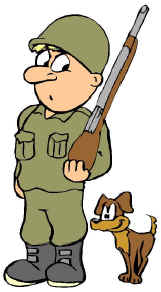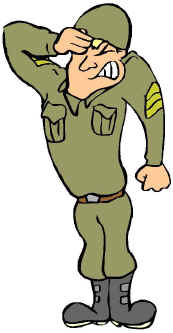Dismounted Drill
|
It's too bad
she won't live! But then again, who does?
Blade Runner |
D Vautier
11/2006
Over time the military found it was easier to move
large numbers of troops by marching soldiers around in step. This worked pretty well as long as everybody had the same size
legs, and as long as they didn’t cross a bridge or trestle,
because the harmonic resonance of the bridge may be the same as the
marchers, and could cause the bridge to collapse. This used to
happen.
So
because of all the little oddities, such as different leg sizes and bridges
and trestles, the military came up with a bunch of commands to deal with just
about every possible situation when moving large groups of soldiers in the
field. This wonderful collection of commands makes up the science
called Dismounted Drill, its very own rich and powerful tool.
 For example, when issuing a command, you can’t just
say “go” or “stop”. You
have to use a well-developed dialect.
Each command consists of a preparatory phrase, such as
“forward” (faaawwwwd) or “left shoulder” (lefshldrrrrr) or “order”
(oderrrrrr) so everybody kind of
knows what to do next, followed by the command itself, like “march” (harrrrch)
or
“arms” (harrrms) or “face” (hassse). But
the way, as you will notice, these commands are spoken in quite a different
way from the way they are spelled or spoken in everyday English. The
command “forward march” sounds like “fwwwrrrd Harch.”
The harch is an unpronounceable guttural sound that originates deep in the throat.
By
using a lot of breath to force it up and out, it finally emerges as a harsh
and obnoxious sound, yet very recognizable to the marching multitudes.
Just try to imagine that you are a karate black-belt and
someone has just slept with your wife, and you want to remove all his vital
organs with the back of your hand. At
this point you are in the right frame of mind for a good healthy HARCH.
Let’s try it together.
For example, when issuing a command, you can’t just
say “go” or “stop”. You
have to use a well-developed dialect.
Each command consists of a preparatory phrase, such as
“forward” (faaawwwwd) or “left shoulder” (lefshldrrrrr) or “order”
(oderrrrrr) so everybody kind of
knows what to do next, followed by the command itself, like “march” (harrrrch)
or
“arms” (harrrms) or “face” (hassse). But
the way, as you will notice, these commands are spoken in quite a different
way from the way they are spelled or spoken in everyday English. The
command “forward march” sounds like “fwwwrrrd Harch.”
The harch is an unpronounceable guttural sound that originates deep in the throat.
By
using a lot of breath to force it up and out, it finally emerges as a harsh
and obnoxious sound, yet very recognizable to the marching multitudes.
Just try to imagine that you are a karate black-belt and
someone has just slept with your wife, and you want to remove all his vital
organs with the back of your hand. At
this point you are in the right frame of mind for a good healthy HARCH.
Let’s try it together.
FWWWRRRD HARCH. Once again. A little
deeper in the throat and from the diaphragm please.
FWWWRRRD HARCH. A little more raspy breath please.
FWWWRRRD HARCH. That’s it. you've got it.
 But
there’s a lot more commands in this mysterious science, some
confusing and contradictory, such as in the case of “at ease” and “at ease”.
The first at ease is issued by a sergeant and sounds like “Ut Hease”.
Given from the position of attention (A-tennn-hugh)
you move your right foot out 10 inches, and place your hands behind your
back. At ease is usually issued
without arms, and can only be issued at order arms (that
means your weapon is at your side with the rifle butt touching the right
heal). So the sergeant must say
order arms (Oddrr Harms) and then the at ease command may be given.
Just imagine the embarrassment and frustration of some idiot sergeant
who ordered an at ease command while the troops were still at right-shoulder
arms—the poor guy would never live it down. (Sorry, I just couldn’t
resist that one).
But
there’s a lot more commands in this mysterious science, some
confusing and contradictory, such as in the case of “at ease” and “at ease”.
The first at ease is issued by a sergeant and sounds like “Ut Hease”.
Given from the position of attention (A-tennn-hugh)
you move your right foot out 10 inches, and place your hands behind your
back. At ease is usually issued
without arms, and can only be issued at order arms (that
means your weapon is at your side with the rifle butt touching the right
heal). So the sergeant must say
order arms (Oddrr Harms) and then the at ease command may be given.
Just imagine the embarrassment and frustration of some idiot sergeant
who ordered an at ease command while the troops were still at right-shoulder
arms—the poor guy would never live it down. (Sorry, I just couldn’t
resist that one).
Now there’s the other at ease, issued in a normal
voice “at ease”. This at
ease means that you can move all around, scratch yourself, stretch your
balls, as long
as you keep your left foot in place. Sometimes
it’s OK to talk and light up too, but you usually should wait for the sergeant
to say, “light ‘em up”. That’s
another command I think.
My favorite is “route step march”
(rut stp haurch)
which means walk any way you want to as long as you’re not in step with
anybody else, which is really hard to do, or easy to do if you don't really
care. But why do they
say march (harch), when they are telling us to walk like normal people? (a mystery).
Many other strange DD commands fill my mind, like left
shoulder arms, port arms, right-shoulder arms, left face, right face, about
face. They never did have a
three-quarter face command. I
can see it now (three-quarter HASE).
Then there’s the file commands; dress left, dress
right, and cover. The idea is
to arrange yourselves in nice need rows and columns.
I think we all should learn dismounted drill--good
for the soul.
 For example, when issuing a command, you can’t just
say “go” or “stop”. You
have to use a well-developed dialect.
Each command consists of a preparatory phrase, such as
“forward” (faaawwwwd) or “left shoulder” (lefshldrrrrr) or “order”
(oderrrrrr) so everybody kind of
knows what to do next, followed by the command itself, like “march” (harrrrch)
or
“arms” (harrrms) or “face” (hassse). But
the way, as you will notice, these commands are spoken in quite a different
way from the way they are spelled or spoken in everyday English. The
command “forward march” sounds like “fwwwrrrd Harch.”
The harch is an unpronounceable guttural sound that originates deep in the throat.
By
using a lot of breath to force it up and out, it finally emerges as a harsh
and obnoxious sound, yet very recognizable to the marching multitudes.
Just try to imagine that you are a karate black-belt and
someone has just slept with your wife, and you want to remove all his vital
organs with the back of your hand. At
this point you are in the right frame of mind for a good healthy HARCH.
Let’s try it together.
For example, when issuing a command, you can’t just
say “go” or “stop”. You
have to use a well-developed dialect.
Each command consists of a preparatory phrase, such as
“forward” (faaawwwwd) or “left shoulder” (lefshldrrrrr) or “order”
(oderrrrrr) so everybody kind of
knows what to do next, followed by the command itself, like “march” (harrrrch)
or
“arms” (harrrms) or “face” (hassse). But
the way, as you will notice, these commands are spoken in quite a different
way from the way they are spelled or spoken in everyday English. The
command “forward march” sounds like “fwwwrrrd Harch.”
The harch is an unpronounceable guttural sound that originates deep in the throat.
By
using a lot of breath to force it up and out, it finally emerges as a harsh
and obnoxious sound, yet very recognizable to the marching multitudes.
Just try to imagine that you are a karate black-belt and
someone has just slept with your wife, and you want to remove all his vital
organs with the back of your hand. At
this point you are in the right frame of mind for a good healthy HARCH.
Let’s try it together. But
there’s a lot more commands in this mysterious science, some
confusing and contradictory, such as in the case of “at ease” and “at ease”.
The first at ease is issued by a sergeant and sounds like “Ut Hease”.
Given from the position of attention (A-tennn-hugh)
you move your right foot out 10 inches, and place your hands behind your
back. At ease is usually issued
without arms, and can only be issued at order arms (that
means your weapon is at your side with the rifle butt touching the right
heal). So the sergeant must say
order arms (Oddrr Harms) and then the at ease command may be given.
Just imagine the embarrassment and frustration of some idiot sergeant
who ordered an at ease command while the troops were still at right-shoulder
arms—the poor guy would never live it down. (Sorry, I just couldn’t
resist that one).
But
there’s a lot more commands in this mysterious science, some
confusing and contradictory, such as in the case of “at ease” and “at ease”.
The first at ease is issued by a sergeant and sounds like “Ut Hease”.
Given from the position of attention (A-tennn-hugh)
you move your right foot out 10 inches, and place your hands behind your
back. At ease is usually issued
without arms, and can only be issued at order arms (that
means your weapon is at your side with the rifle butt touching the right
heal). So the sergeant must say
order arms (Oddrr Harms) and then the at ease command may be given.
Just imagine the embarrassment and frustration of some idiot sergeant
who ordered an at ease command while the troops were still at right-shoulder
arms—the poor guy would never live it down. (Sorry, I just couldn’t
resist that one).